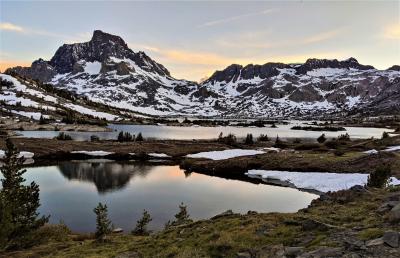Will Midlatitude Mountain Snowpacks Respond Similarly to Climate Change?
Mountains function as vast natural water towers through their storage and release of snowpack. Climate change could significantly alter the amount, extent, and persistence of snowpack. The warming levels at which deleterious, widespread, and persistent snow loss in mountain regions remains uncertain. Differences in mountain susceptibility to persistent snowpack decline is dependent on a combination of factors such as dynamical, thermodynamical, and hypsometric. This study contrasts snowpack decline in relation to these three factors in two mountainous regions that have been described historically as hydroclimatic “mirror images” of one another using an ensemble of Earth system model simulations.
Snowpack is key to water supply reliability in the world’s longest series of mountains (American Cordillera). This study identifies the dates and local warming levels that give rise to low-to-no snow emergence in the midlatitudes of the northern (2070s at +3.5°C) and southern (2050s at +1.2°C) portions of the American Cordillera and results in a widespread loss in runoff efficiency (-8% on average). These findings highlight how climate change can differentially impact regional hydrologic cycles that share historical commonality and the timing of these impacts have important implications for adaptation planning horizons in water resource management.
The American Cordillera is the world’s longest series of mountains, spanning Alaska through Chile, and extracts and stores vast amounts of atmospheric moisture in snowpack and glaciers. Therefore, societies that reside near the American Cordillera, particularly in midlatitudes, have become heavily dependent on snowmelt to meet water demand. Historically, the northern and southern midlatitudes of the American Cordillera share hydrologic cycle commonalities (oft described as “mirror images”), this study provides evidence that climate change could asymmetrically impact them resulting in hydrologic cycles that are “distorted mirror images”.
Using a cutting-edge ensemble of high-resolution Earth system models (HighResMIP) we find that persistent low-to-no snow conditions in southern midlatitudes of the American Cordillera occur 20 years earlier (2050s vs 2070s) and at a third of the regional warming level (+1.2°C vs +3.5°C) than in the northern midlatitudes. The level of global warming needed to prevent a persistent low-to-no snow future in either hemisphere is +2.5°C. Factors that give rise to asymmetric low-to-no snow emergence are contrasted between hemispheres such as dynamical (e.g., circulation changes), thermodynamical (e.g., rain-snow partitioning), and hypsometric (e.g., elevation). Notably, post emergence of low-to-no snow, runoff efficiency declines (∼8% avg) in both dry and wet years and across hemispheres.

